Two Step Random Access Latency Improvement in Congested beyond 5G Networks
Abstract
1. Introduction
- The aim of this paper is to explore methods to reduce the average 2s-RAP latency in the congested and dense networks while also considering 4s-RAP simultaneously. More specifically, we propose and analyze novel algorithms to decide whether UEs should attempt 2s-RAP or 4s-RAP such that the overall delay and success rate of RAP improves.
- The existing 3GPP proposal considers that, if an attempt by a UE fails, then it can reattempt the RAP with its initial choice of either 2s-RAP or 4s-RAP only. In the existing proposal, the UE does not have any flexibility to change its choice in case of reattempt after an RA attempt failure. However, we believe that the existing approach lacks dynamism and thus propose two novel algorithms.
- We first consider that the UEs can initiate RAP with either 2s-RAP or 4s-RAP based on the channel conditions. While 2s-RAP provides agility for UEs having good channel, the UEs with poor channel can select 4s-RAP so that the two step congestion can be reduced. Subsequently, at every RAP reattempt, the choice of 2s-RAP or 4s-RAP is reaffirmed. The re-selection ensures that the chance of failure due to poor channels are reduced for the UEs attempting 2s-RAP. We call this novel proposal a Reasserting Algorithm (ReA).
- We also propose a novel Sequential Algorithm (SeA). Similar to ReA, the SeA as well the UEs can initiate with either 2s-RAP or 4s-RAP based on the channel conditions. However, in SeA, we propose that, if a 2s-RAP attempt by a UE fails, then it can reattempt with 2s-RAP itself without any channel reassessing. However, it can do so for the configured number of trials only after which it transits to 4s-RAP. SeA gives UEs a fair chance at 2s-RAP reattempts while at the same time controlling the 2s-RAP congestions if the failures persist.
- We also perform delay analysis for the existing base line case in accordance with the current 3GPP study on 2s-RAP [6]. For the existing case as well, the UE selects either 2s-RAP or 4s-RAP for the first trial based on the channel conditions. If an attempt by an UE fails, then it can reattempt the RAP with its initial choice only. Since the UE performing RAP reattempt follows the preceding choice, we call this base line case the Preceding Algorithm (PrA).
- We perform probabilistic analysis for the three protocols and compare the results in terms of delay and success rate for the different arrival rates. ReA, SeA, and PrA are also compared to legacy 4s-RAP to ascertain their advantages. We also validate our analysis with simulation studies. We also compare our results with existing work on 2-way RAP [11].
2. Evolution of the Random Access Process
2.1. Four Step RAP
- Step 1: Msg1UE randomly selects one of the available preamble sequences associated with the PRACH Occasion [12]. It transmits the selected Preamble on the random access channel. This transmission carries no data bits. Some identity is needed for this UE so that the network can address it in the next step. The identity is called RA-RNTI (random access radio network temporary identity) and is implicitly specified by the timing of the preamble transmission. Some other UE can also select the same preamble sequence and may transmit at the same time [13]. Thus, it would also assume same the RA-RNTI. However, neither the network nor the UEs can be aware of this contention at this step.
- Step 2: Msg2The gNB detects the transmitted preamble and derives the RA-RNTI based on the time slot in which the preamble was sent. The gNB transmits RA response (RAR) that carries (i) ID of successfully received preambles (ii) Temporary CRNTI (Cell Radio Network Temporary Identifier) (iii) PUSCH uplink grants for Msg3 (iv) timing advance [13]. The UE checks PDCCH addressed to RA-RNTI and can subsequently receive MAC PDUs in PDSCH that contain the aforesaid information.
- Step 3: Msg3UE saves the Temporary C-RNTI, applies timing advance, and then transmits the data to gNB using the PUSCH resources assigned in step 2. The MAC PDU (Medium access control (MAC) layer protocol data unit (PDU)) in PUSCH contains UEID. It is possible that more than one UE attempted RA using the same preamble on the same RA channel [13]. Even the UE whose preamble was not received by the gNB successfully would accept the RA response as the RA-RNTI and preamble ID in the RAR response in Msg2 matches. The contention resolution (CR) in step 4 is therefore needed to resolve this issue.
- Step 3: Msg4The gNB responds Msg3 with the CR message that contains the UEID which was was successfully received in step 3. The UE monitors PDCCH is addressed to Temporary C-RNTI. Similar to RAR, if multiple UEs transmitted the same preamble in step 1, they would receive the same Temporary C-RNTI and would decode this CR message. However, on verifying the echoed UEID in Msg4, the UE would become aware if its RA attempt was successful or not. The CR aids in unique identification of the UE that has been able to successfully transmit the preamble in step 1 [14].
2.2. Novel Two Step RAP
- Step 1 (MsgA):In MsgA, the UE is required to transmit the preamble using PRACH along with a data unit in PUSCH that contains UEID for contention resolution as shown in Figure 1 [15]. The data unit is sent in Msg3 in 4s-RAP and can be regarded as payload carried on PUSCH in 2s-RAP [3]. Thus, the network should not only reserve the preambles and PRACH resources but also PUSCH resources for MsgA transmission in 2s-RAP which are shared by all of the UEs attempting contention based RAP. The network can configure PUSCH resources to be associated with the PRACH resource based on predefined rules.
- Step 2 (MsgB):When the gNB successfully receives the preamble as well as the MsgA PUSCH, it sends back a response to the UE as MsgB. As shown in Figure 1, MsgB contains UEID for contention resolution (which was Msg4 in 4s-RAP). The UE, after having transmitted MsgA, waits for the MsgB response from the gNB. If the received response contains the UEID, the one that it had sent in MsgA, then the RAP is considered to be successfully completed. However, if the correct response is not received, the UE can consider its RA attempt as unsuccessful and can re-transmit MsgA.
2.3. Related Work
3. System Model
3.1. Reasserting Algorithm (ReA)
| Algorithm 1 2s-RAP and 4s-RAP using reasserting algorithm (ReA) |
|
3.2. Sequential Algorithm (SeA)
| Algorithm 2 2s-RAP and 4s-RAP using sequential algorithm (SeA) |
|
3.3. Preceding Algorithm (PrA)
| Algorithm 3 2s-RAP and 4s-RAP using preceding algorithm (PrA) |
|
4. Performance Evaluations
- In the first step, the active UEs are randomly distributed and can select either 2s-RAP or 4s-RAP for the first attempt based on a randomly chosen value of ‘q’. For attempt/reattempt, the UE competes for preambles allocated to its selection along with the newly activated UEs that are generated based on Poisson.
- To perform random access, the ‘N’; active UEs select the preambles for transmission. The selected preamble is checked. If two or more UEs select the same preamble in the same time slot, then it results in a collision. The UE can successfully transmit if its selected preamble is different from other UEs.
- The collided UEs are carried forward to the next time slot. They can reattempt using either 2s-RAP preambles or 4s-RAP preambles based on ReA, SeA, and PrA logic. For ReA, UE randomly selects a value of ‘q’ and, based on specified channel probability, it can be considered either in 2s-RAP or 4s-RAP. For SeA, after 2s-RAP failure, it keeps selecting preambles allocated to 2s-RAP until ‘’ attempts are expired. For PeA, the UE re-selects the preambles associated with the initial choice only.
- We use slotted Aloha such that there are N number of UEs for a given number of preambles at the start of every simulation slot. For obtaining N, we consider the UEs that have already collided and are required to reattempt RAP along with the newly activated UEs.
- The simulations are repeated 10,000 times. At the end of simulation, the number of attempts in both 2s-RAP and 4s-RAP are recorded and average delay is calculated.
5. Conclusions
Author Contributions
Funding
Acknowledgments
Conflicts of Interest
References
- Qamar, F.; Siddiqui, M.U.A.; Hindia, M.H.D.; Hassan, R.; Nguyen, Q.N. Issues, Challenges, and Research Trends in Spectrum Management: A Comprehensive Overview and New Vision for Designing 6G Networks. Electronics 2020, 9, 1416. [Google Scholar] [CrossRef]
- Letaief, K.B.; Chen, W.; Shi, Y.; Zhang, J.; Zhang, Y.J.A. The Roadmap to 6G: AI Empowered Wireless Networks. IEEE Commun. Mag. 2019, 57, 84–90. [Google Scholar] [CrossRef]
- Li, Y.R.; Chen, M.; Xu, J.; Tian, L.; Huang, K. Power Saving Techniques for 5G and Beyond. IEEE Access 2020, 8, 108675–108690. [Google Scholar] [CrossRef]
- Agiwal, M.; Maheshwari, M.K.; Jin, H. Power Efficient Random Access for Massive NB-IoT Connectivity. Sensors 2019, 19, 4944. [Google Scholar] [CrossRef] [PubMed]
- Cheng, R.; Becvar, Z.; Huang, Y.; Bianchi, G.; Harwahyu, R. Two-Phase Random Access Procedure for LTE-A Networks. IEEE Trans. Wirel. Commun. 2019, 18, 2374–2387. [Google Scholar] [CrossRef]
- 3GPP TS 38.300 V16.1.0. NR; NR and NG-RAN Overall Description. 2019. Available online: https://portal.3gpp.org/desktopmodules/Specifications/SpecificationDetails.aspx?specificationId=3191 (accessed on 7 February 2020).
- Thota, J.; Aijaz, A. On Performance Evaluation of Random Access Enhancements for 5G uRLLC. In Proceedings of the 2019 IEEE Wireless Communications and Networking Conference (WCNC), Marrakesh, Morocco, 15–19 April 2019. [Google Scholar]
- Condoluci, M.; Dohler, M.; Araniti, G.; Molinaro, A.; Sachs, J. Enhanced Radio Access and Data Transmission Procedures Facilitating Industry Compliant Machine Type Communications over LTE-based 5G Networks. IEEE Wirel. Commun. 2016, 23, 56–63. [Google Scholar] [CrossRef]
- Raftopoulou, M. Design and Assessment of Random Access Procedures Supporting Massive Connectivity and Low-Delay and High-Reliability Services in 5G. Master’s Thesis, Delft University of Technology, Delft, The Netherlands, 2018. Available online: https://repository.tudelft.nl/islandora/object/uuid%3A755177df-56bd-48d5-9e57-50198bd06af6 (accessed on 7 February 2020).
- Toor, W.T.; Basit, A.; Maroof, N.; Khan, S.A.; Saadi, M. Evolution of random access process: From Legacy networks to 5G and beyond. Trans. Emerg. Telecommun. Technol. 2019, e3776. [Google Scholar] [CrossRef]
- Kim, S.; Kim, S.; Kim, J.; Lee, K.; Choi, S.; Shim, B. Low Latency Random Access for Small Cell Toward Future Cellular Networks. IEEE Access 2019, 7, 178563–178576. [Google Scholar] [CrossRef]
- Dawy, Z.; Saad, W.; Ghosh, A.; Andrews, J.G.; Yaacoub, E. Toward massive machine type cellular communications. IEEE Wirel. Commun. 2017, 24, 120–128. [Google Scholar] [CrossRef]
- Ali, M.S.; Hossain, E.; Kim, D.I. LTE/LTE-A Random Access for Massive Machine-Type Communications in Smart Cities. IEEE Commun. Mag. 2017, 55, 76–83. [Google Scholar] [CrossRef]
- Jin, H.; Toor, W.T.; Jung, B.C.; Seo, J. Recursive Pseudo-Bayesian Access Class Barring for M2M Communications in LTE Systems. IEEE Trans. Veh. Technol. 2017, 66, 8595–8599. [Google Scholar] [CrossRef]
- 3GPP TR 38.821 V16.0.0. Solutions for NR to Support Non-Terrestrial Networks (NTN) (Release 16). 2019. Available online: https://portal.3gpp.org/desktopmodules/Specifications/SpecificationDetails.aspx?specificationId=3525 (accessed on 7 February 2020).
- 3GPP TS 38.321 V15.8.0. Medium Access Control (MAC) Protocol Specification (Release 15). 2019. Available online: https://portal.3gpp.org/desktopmodules/Specifications/SpecificationDetails.aspx?specificationId=3194 (accessed on 7 February 2020).
- Liu, J.; Agiwal, M.; Qu, M.; Jin, H. Online Control of Preamble Groups with Priority in Massive IoT Networks. IEEE J. Sel. Areas Commun. 2020. [Google Scholar] [CrossRef]
- Chen, Y.; Cheng, L.; Wang, L. Prioritized resource reservation for reducing random access delay in 5G URLLC. In Proceedings of the 2017 IEEE 28th Annual International Symposium on Personal, Indoor, and Mobile Radio Communications (PIMRC), Montreal, QC, Canada, 8–13 October 2017; pp. 1–5. [Google Scholar]
- Akudo Nwogu, O.; Diaz, G.; Abdennebi, M. A Combined Static/Dynamic Partitioned Resource Usage Approach for Random Access in 5G Cellular Networks. In Proceedings of the 2019 International Conference on Software, Telecommunications and Computer Networks (SoftCOM), Split, Croatia, 19–21 September 2019; pp. 1–6. [Google Scholar]
- 3GPP. RAN Improvements for Machine Type Communications. 3rd Generation Partnership Project (3GPP), TR 37.868 V11.0.0. 2011. Available online: http://www.3gpp.org/ftp/Specs/archive/37series/37.868/ (accessed on 7 August 2019).
- Popovski, P.; Stefanović, C.; Nielsen, J.J.; De Carvalho, E.; Angjelichinoski, M.; Trillingsgaard, K.F.; Bana, A.S. Wireless access in ultra-reliable low-latency communication (URLLC). IEEE Trans. Commun. 2019, 67, 5783–5801. [Google Scholar] [CrossRef]
- Singh, B.; Tirkkonen, O.; Li, Z.; Uusitalo, M.A. Contention-based access for ultra-reliable low latency uplink transmissions. IEEE Wirel. Commun. Lett. 2017, 7, 182–185. [Google Scholar] [CrossRef]
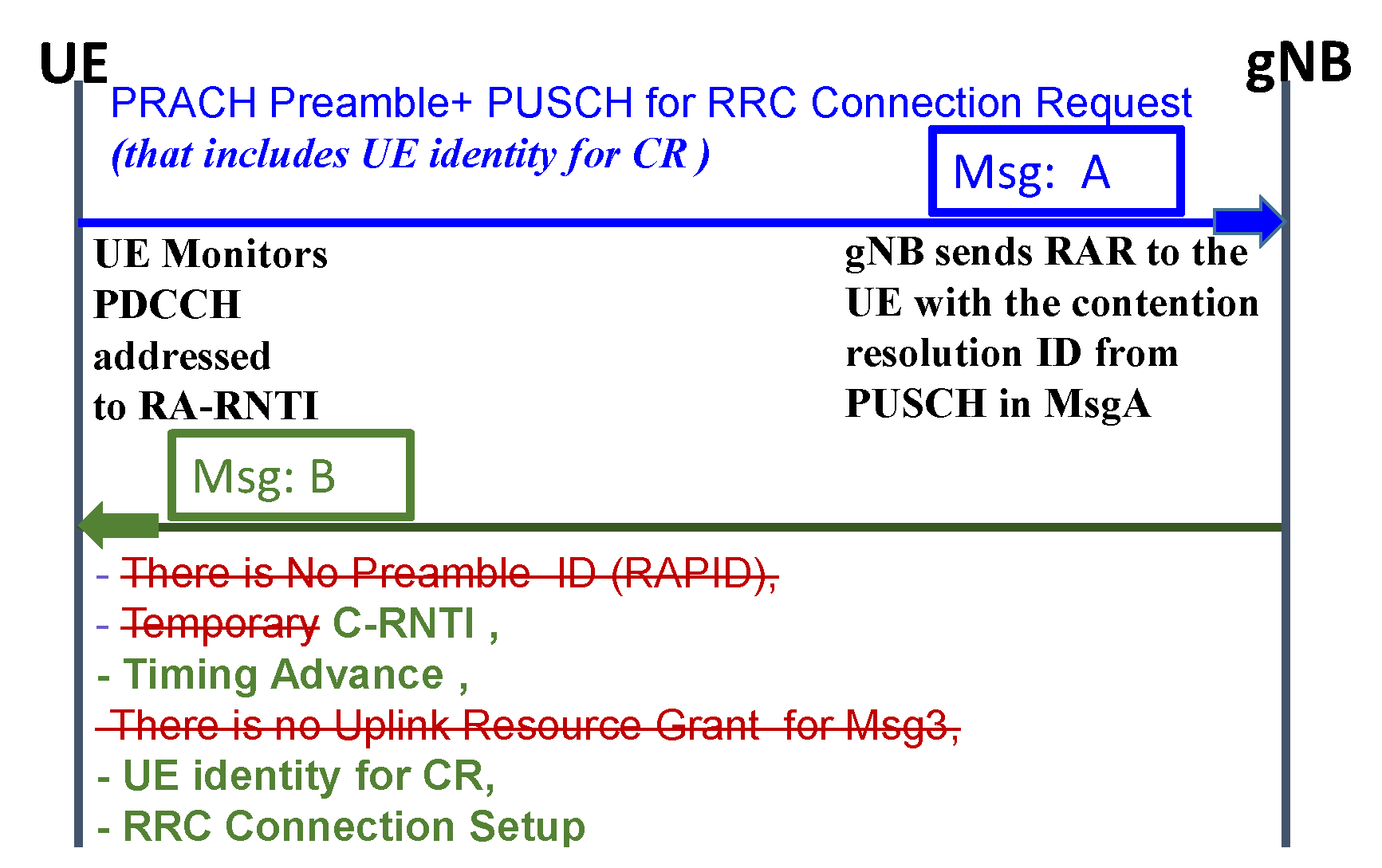
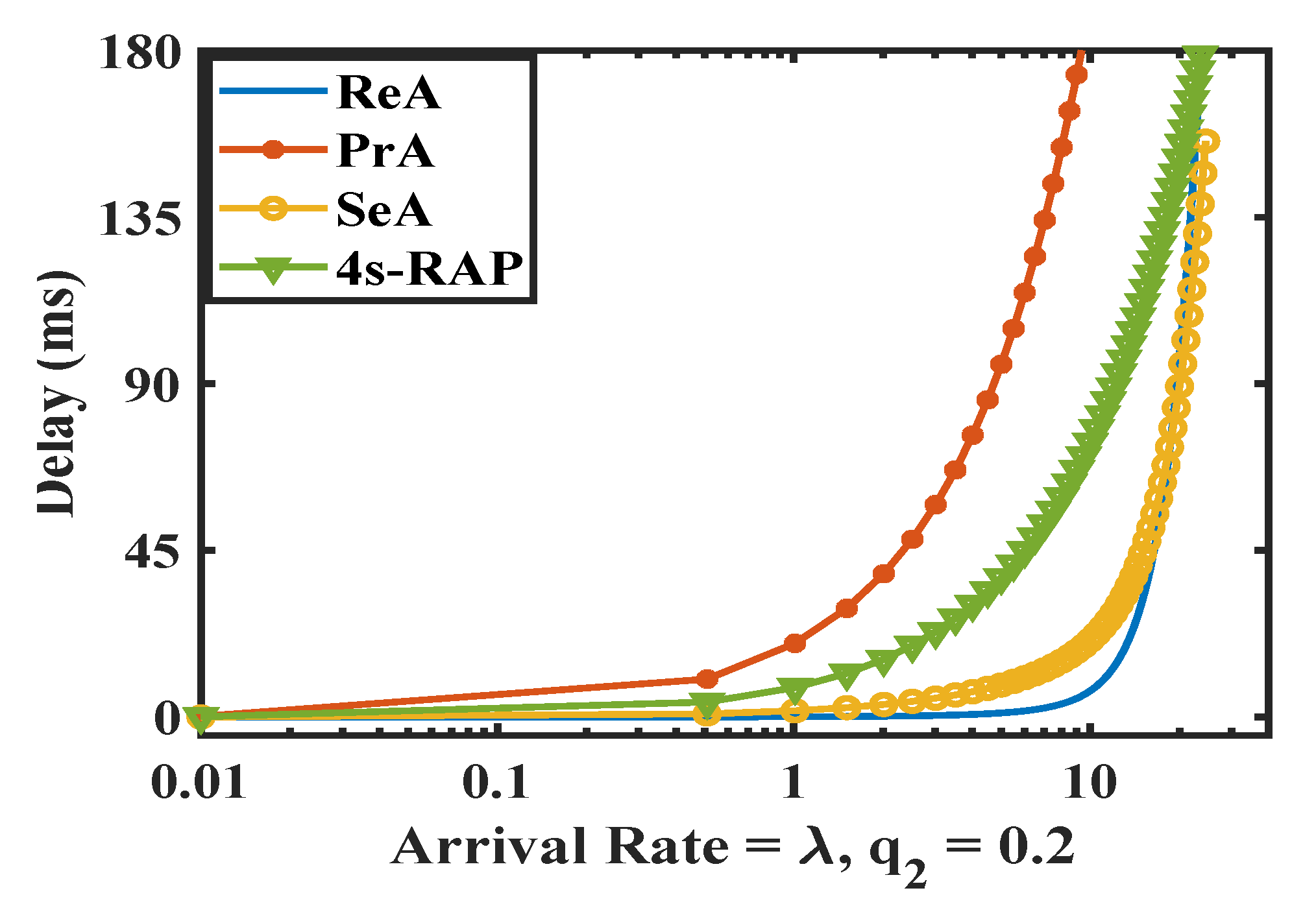
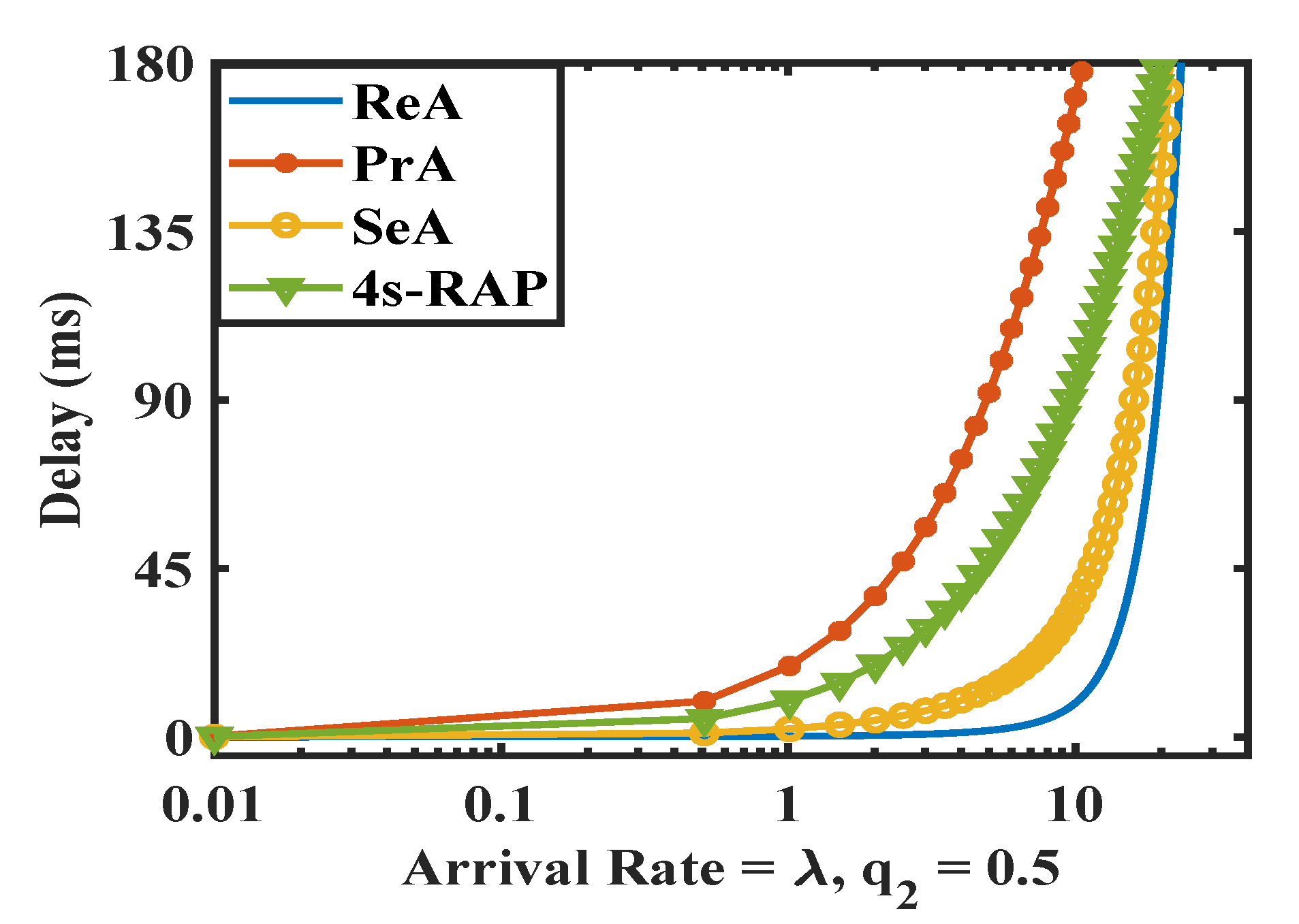
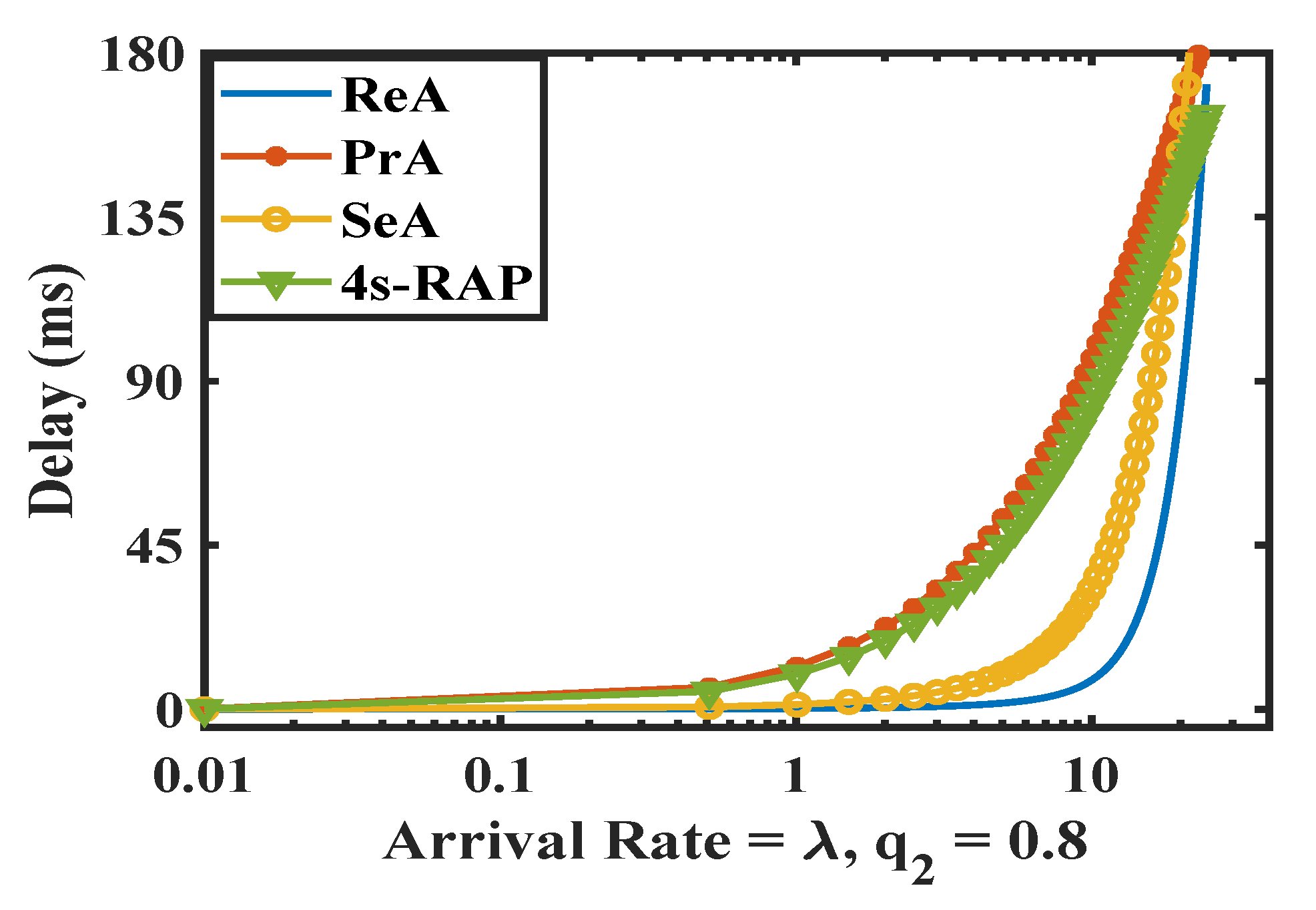

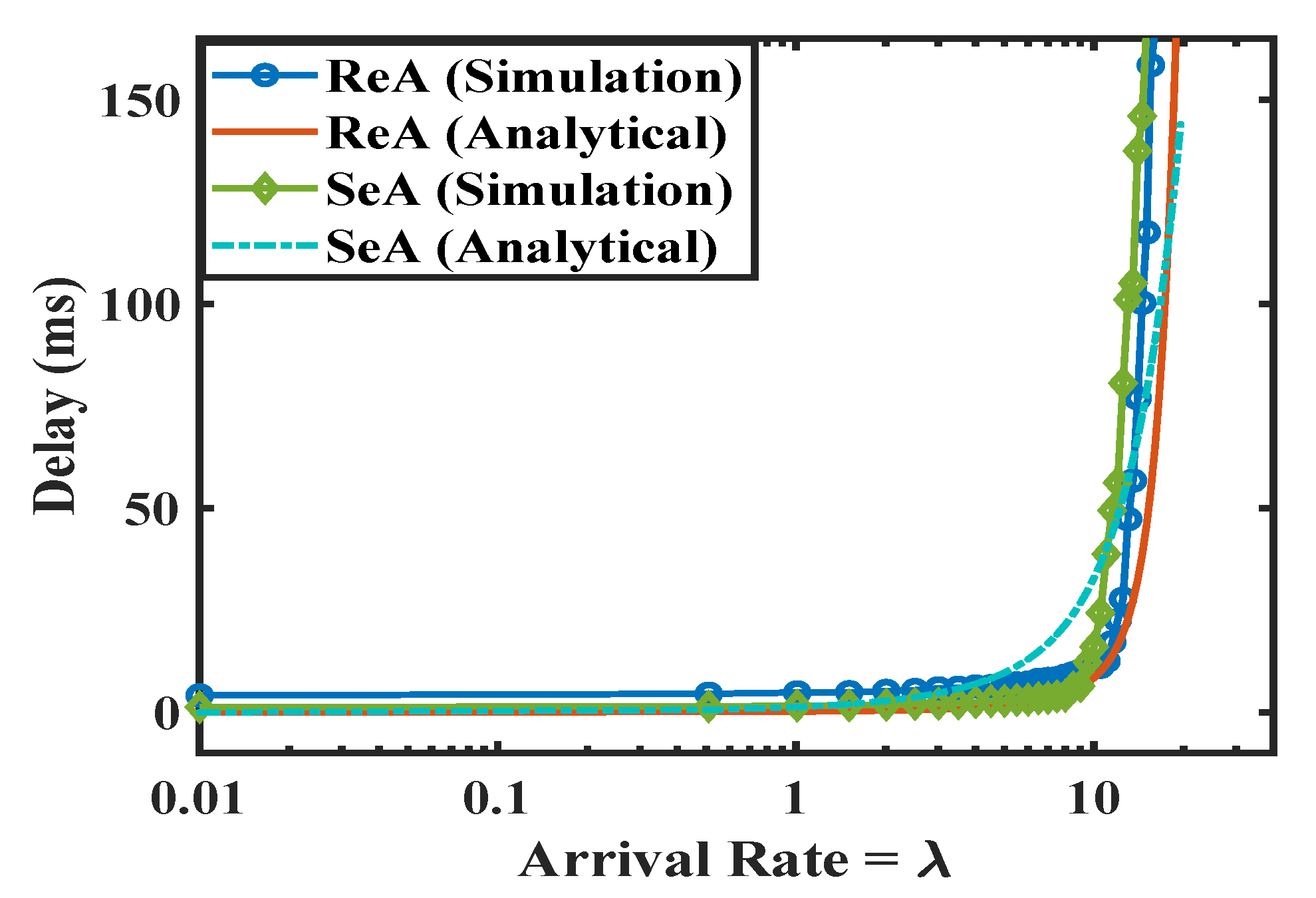
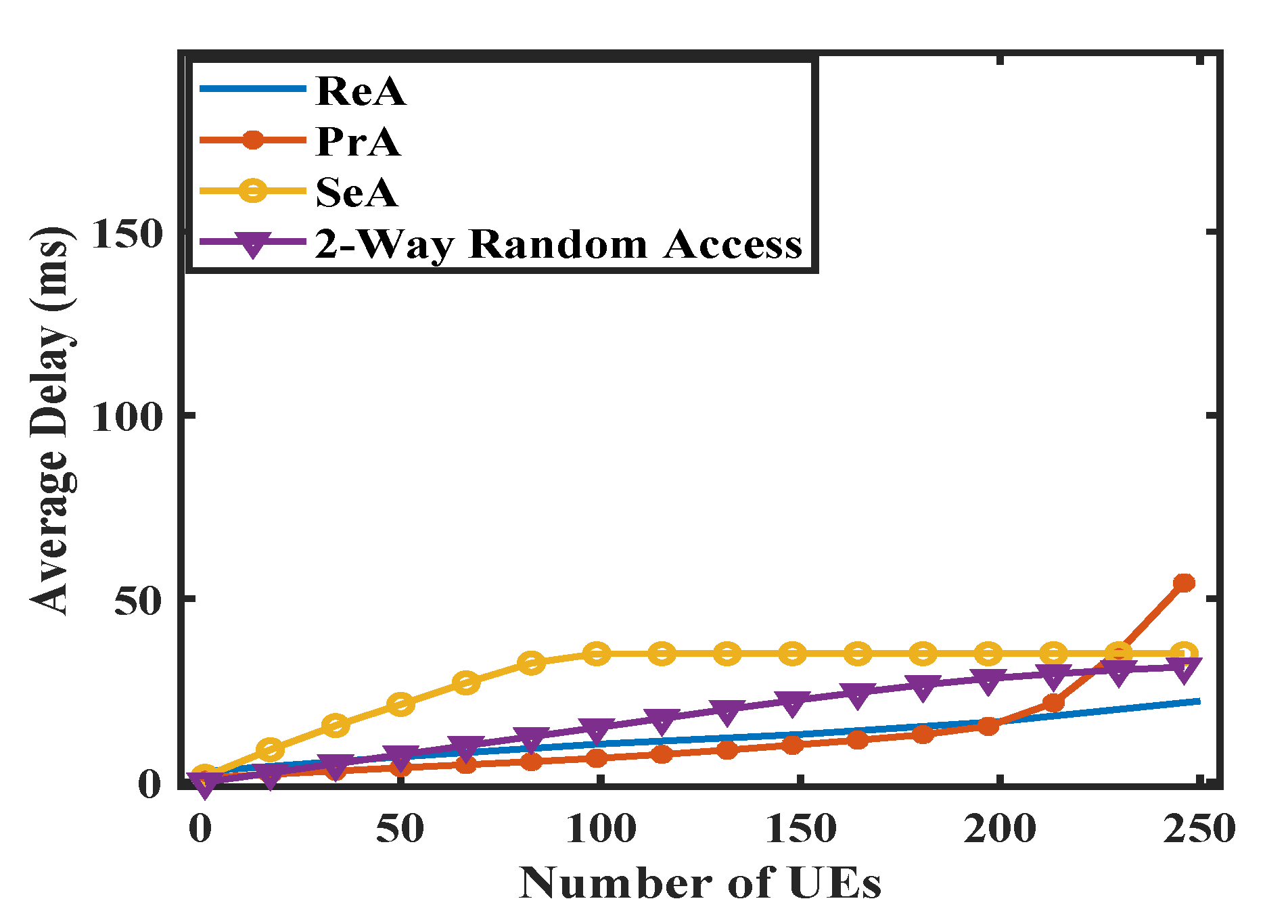
| Random Access | Number of Messages | Flexibility | Preamble Redesign | Effect of Channel Variations |
|---|---|---|---|---|
| ReA | For some UEs 2 and for some UEs 4 (Selection of 2s-RAP or 4s-RAP is not fixed) | High | No | Low |
| SeA | For some UEs 2 and for some UEs 4 (Number of times 2s-RAP is selected per UE is fixed) | Partial | No | Partial |
| PrA | For some UEs 2 and for some UEs 4 (Selection of 2s or 4s step is fixed) | Low | No | Not considered |
| 2s-RAP | For all UEs 2 | Low | No | Not considered |
| 4s-RAP | For all UEs 4 | Low | No | Not considered |
| [11] | For all UEs 2 | Low | Yes | Not considered |
| Parameter | Value |
|---|---|
| Arrival Rate () | 0.01∼25 |
| Total number of preambles | 64 |
| Reserved preambles | 10 |
| No. of Preamble for 2s-RAP () | of Total preamble |
| No. of Preamble for 4s-RAP () | of Total preamble |
| Delay for 2s-RAP () | 1 ms |
| Delay for 4s-RAP () | 2 ms |
| Probability of 2s-RAP Channel Condition () | |
| 5 |
Publisher’s Note: MDPI stays neutral with regard to jurisdictional claims in published maps and institutional affiliations. |
© 2020 by the authors. Licensee MDPI, Basel, Switzerland. This article is an open access article distributed under the terms and conditions of the Creative Commons Attribution (CC BY) license (http://creativecommons.org/licenses/by/4.0/).
Share and Cite
Agiwal, M.; Maheshwari, M.K.; Toor, W.T. Two Step Random Access Latency Improvement in Congested beyond 5G Networks. Electronics 2020, 9, 1974. https://doi.org/10.3390/electronics9111974
Agiwal M, Maheshwari MK, Toor WT. Two Step Random Access Latency Improvement in Congested beyond 5G Networks. Electronics. 2020; 9(11):1974. https://doi.org/10.3390/electronics9111974
Chicago/Turabian StyleAgiwal, Mamta, Mukesh Kumar Maheshwari, and Waqas Tariq Toor. 2020. "Two Step Random Access Latency Improvement in Congested beyond 5G Networks" Electronics 9, no. 11: 1974. https://doi.org/10.3390/electronics9111974
APA StyleAgiwal, M., Maheshwari, M. K., & Toor, W. T. (2020). Two Step Random Access Latency Improvement in Congested beyond 5G Networks. Electronics, 9(11), 1974. https://doi.org/10.3390/electronics9111974





